Kushal Kafle
Calibrating MLLM-as-a-judge via Multimodal Bayesian Prompt Ensembles
Sep 10, 2025Abstract:Multimodal large language models (MLLMs) are increasingly used to evaluate text-to-image (TTI) generation systems, providing automated judgments based on visual and textual context. However, these "judge" models often suffer from biases, overconfidence, and inconsistent performance across diverse image domains. While prompt ensembling has shown promise for mitigating these issues in unimodal, text-only settings, our experiments reveal that standard ensembling methods fail to generalize effectively for TTI tasks. To address these limitations, we propose a new multimodal-aware method called Multimodal Mixture-of-Bayesian Prompt Ensembles (MMB). Our method uses a Bayesian prompt ensemble approach augmented by image clustering, allowing the judge to dynamically assign prompt weights based on the visual characteristics of each sample. We show that MMB improves accuracy in pairwise preference judgments and greatly enhances calibration, making it easier to gauge the judge's true uncertainty. In evaluations on two TTI benchmarks, HPSv2 and MJBench, MMB outperforms existing baselines in alignment with human annotations and calibration across varied image content. Our findings highlight the importance of multimodal-specific strategies for judge calibration and suggest a promising path forward for reliable large-scale TTI evaluation.
Plot'n Polish: Zero-shot Story Visualization and Disentangled Editing with Text-to-Image Diffusion Models
Sep 04, 2025Abstract:Text-to-image diffusion models have demonstrated significant capabilities to generate diverse and detailed visuals in various domains, and story visualization is emerging as a particularly promising application. However, as their use in real-world creative domains increases, the need for providing enhanced control, refinement, and the ability to modify images post-generation in a consistent manner becomes an important challenge. Existing methods often lack the flexibility to apply fine or coarse edits while maintaining visual and narrative consistency across multiple frames, preventing creators from seamlessly crafting and refining their visual stories. To address these challenges, we introduce Plot'n Polish, a zero-shot framework that enables consistent story generation and provides fine-grained control over story visualizations at various levels of detail.
MS4UI: A Dataset for Multi-modal Summarization of User Interface Instructional Videos
Jun 14, 2025Abstract:We study multi-modal summarization for instructional videos, whose goal is to provide users an efficient way to learn skills in the form of text instructions and key video frames. We observe that existing benchmarks focus on generic semantic-level video summarization, and are not suitable for providing step-by-step executable instructions and illustrations, both of which are crucial for instructional videos. We propose a novel benchmark for user interface (UI) instructional video summarization to fill the gap. We collect a dataset of 2,413 UI instructional videos, which spans over 167 hours. These videos are manually annotated for video segmentation, text summarization, and video summarization, which enable the comprehensive evaluations for concise and executable video summarization. We conduct extensive experiments on our collected MS4UI dataset, which suggest that state-of-the-art multi-modal summarization methods struggle on UI video summarization, and highlight the importance of new methods for UI instructional video summarization.
MAGNET: Augmenting Generative Decoders with Representation Learning and Infilling Capabilities
Jan 15, 2025
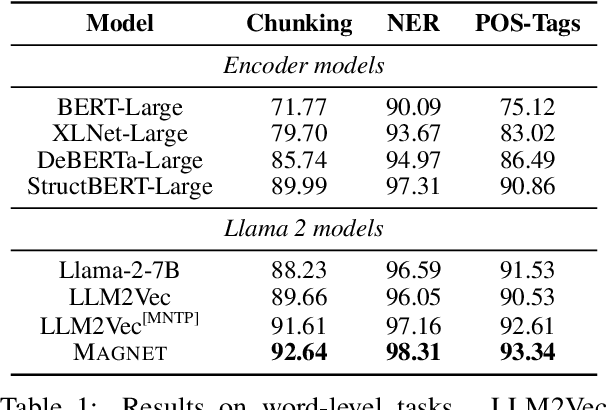
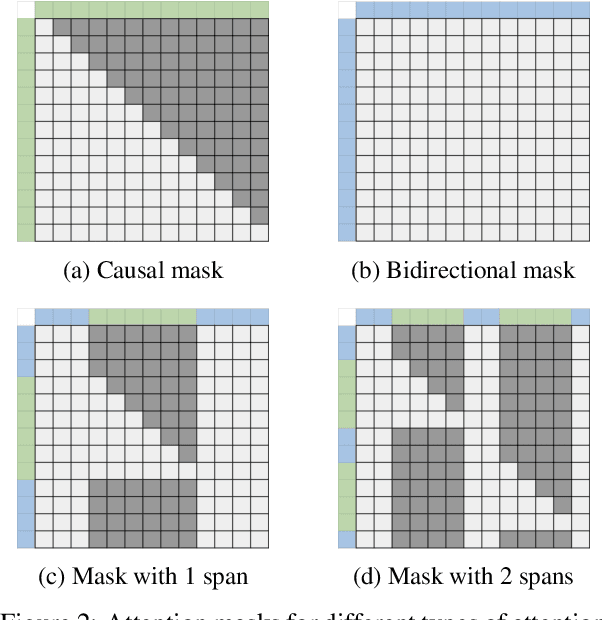
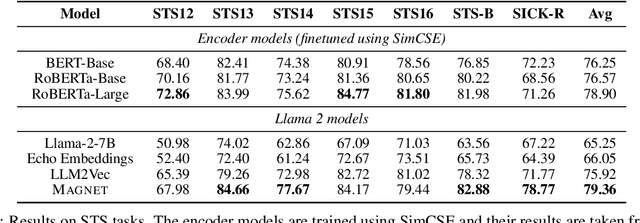
Abstract:While originally designed for unidirectional generative modeling, decoder-only large language models (LLMs) are increasingly being adapted for bidirectional modeling. However, unidirectional and bidirectional models are typically trained separately with distinct objectives (generation and representation learning, respectively). This separation overlooks the opportunity for developing a more versatile language model and for these objectives to complement each other. In this work, we introduce MAGNET, an adaptation of decoder-only LLMs that enhances their ability to generate robust representations and infill missing text spans, while preserving their knowledge and text generation capabilities. MAGNET employs three self-supervised training objectives and introduces an attention mechanism that combines bidirectional and causal attention, enabling unified training across all objectives. Our results demonstrate that LLMs adapted with MAGNET (1) surpass strong text encoders on token-level and sentence-level representation learning tasks, (2) generate contextually appropriate text infills by leveraging future context, (3) retain the ability for open-ended text generation without exhibiting repetition problem, and (4) preserve the knowledge gained by the LLM during pretraining.
Revisiting Multi-Modal LLM Evaluation
Aug 09, 2024
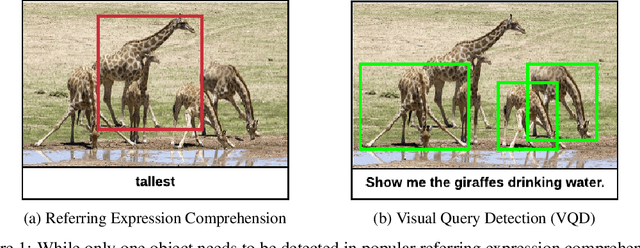

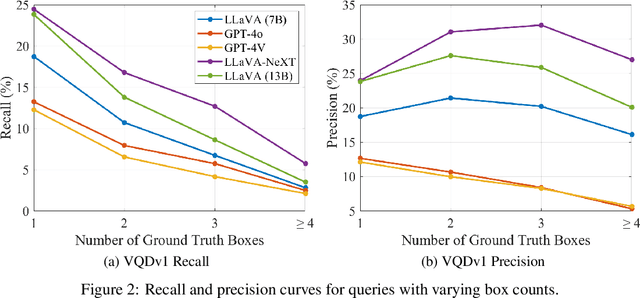
Abstract:With the advent of multi-modal large language models (MLLMs), datasets used for visual question answering (VQA) and referring expression comprehension have seen a resurgence. However, the most popular datasets used to evaluate MLLMs are some of the earliest ones created, and they have many known problems, including extreme bias, spurious correlations, and an inability to permit fine-grained analysis. In this paper, we pioneer evaluating recent MLLMs (LLaVA 1.5, LLaVA-NeXT, BLIP2, InstructBLIP, GPT-4V, and GPT-4o) on datasets designed to address weaknesses in earlier ones. We assess three VQA datasets: 1) TDIUC, which permits fine-grained analysis on 12 question types; 2) TallyQA, which has simple and complex counting questions; and 3) DVQA, which requires optical character recognition for chart understanding. We also study VQDv1, a dataset that requires identifying all image regions that satisfy a given query. Our experiments reveal the weaknesses of many MLLMs that have not previously been reported. Our code is integrated into the widely used LAVIS framework for MLLM evaluation, enabling the rapid assessment of future MLLMs. Project webpage: https://kevinlujian.github.io/MLLM_Evaluations/
They're All Doctors: Synthesizing Diverse Counterfactuals to Mitigate Associative Bias
Jun 17, 2024Abstract:Vision Language Models (VLMs) such as CLIP are powerful models; however they can exhibit unwanted biases, making them less safe when deployed directly in applications such as text-to-image, text-to-video retrievals, reverse search, or classification tasks. In this work, we propose a novel framework to generate synthetic counterfactual images to create a diverse and balanced dataset that can be used to fine-tune CLIP. Given a set of diverse synthetic base images from text-to-image models, we leverage off-the-shelf segmentation and inpainting models to place humans with diverse visual appearances in context. We show that CLIP trained on such datasets learns to disentangle the human appearance from the context of an image, i.e., what makes a doctor is not correlated to the person's visual appearance, like skin color or body type, but to the context, such as background, the attire they are wearing, or the objects they are holding. We demonstrate that our fine-tuned CLIP model, $CF_\alpha$, improves key fairness metrics such as MaxSkew, MinSkew, and NDKL by 40-66\% for image retrieval tasks, while still achieving similar levels of performance in downstream tasks. We show that, by design, our model retains maximal compatibility with the original CLIP models, and can be easily controlled to support different accuracy versus fairness trade-offs in a plug-n-play fashion.
FairDeDup: Detecting and Mitigating Vision-Language Fairness Disparities in Semantic Dataset Deduplication
Apr 24, 2024



Abstract:Recent dataset deduplication techniques have demonstrated that content-aware dataset pruning can dramatically reduce the cost of training Vision-Language Pretrained (VLP) models without significant performance losses compared to training on the original dataset. These results have been based on pruning commonly used image-caption datasets collected from the web -- datasets that are known to harbor harmful social biases that may then be codified in trained models. In this work, we evaluate how deduplication affects the prevalence of these biases in the resulting trained models and introduce an easy-to-implement modification to the recent SemDeDup algorithm that can reduce the negative effects that we observe. When examining CLIP-style models trained on deduplicated variants of LAION-400M, we find our proposed FairDeDup algorithm consistently leads to improved fairness metrics over SemDeDup on the FairFace and FACET datasets while maintaining zero-shot performance on CLIP benchmarks.
FINEMATCH: Aspect-based Fine-grained Image and Text Mismatch Detection and Correction
Apr 23, 2024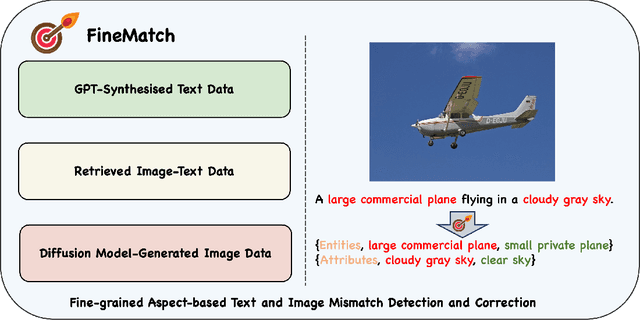

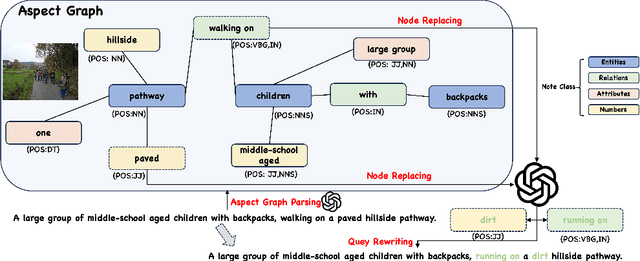
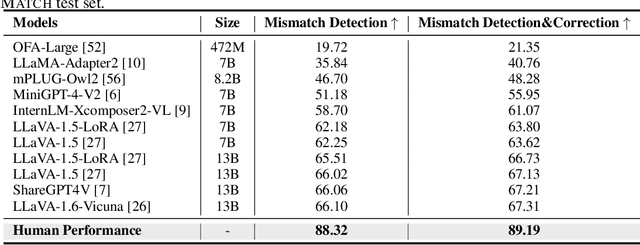
Abstract:Recent progress in large-scale pre-training has led to the development of advanced vision-language models (VLMs) with remarkable proficiency in comprehending and generating multimodal content. Despite the impressive ability to perform complex reasoning for VLMs, current models often struggle to effectively and precisely capture the compositional information on both the image and text sides. To address this, we propose FineMatch, a new aspect-based fine-grained text and image matching benchmark, focusing on text and image mismatch detection and correction. This benchmark introduces a novel task for boosting and evaluating the VLMs' compositionality for aspect-based fine-grained text and image matching. In this task, models are required to identify mismatched aspect phrases within a caption, determine the aspect's class, and propose corrections for an image-text pair that may contain between 0 and 3 mismatches. To evaluate the models' performance on this new task, we propose a new evaluation metric named ITM-IoU for which our experiments show a high correlation to human evaluation. In addition, we also provide a comprehensive experimental analysis of existing mainstream VLMs, including fully supervised learning and in-context learning settings. We have found that models trained on FineMatch demonstrate enhanced proficiency in detecting fine-grained text and image mismatches. Moreover, models (e.g., GPT-4V, Gemini Pro Vision) with strong abilities to perform multimodal in-context learning are not as skilled at fine-grained compositional image and text matching analysis. With FineMatch, we are able to build a system for text-to-image generation hallucination detection and correction.
SCoRD: Subject-Conditional Relation Detection with Text-Augmented Data
Aug 24, 2023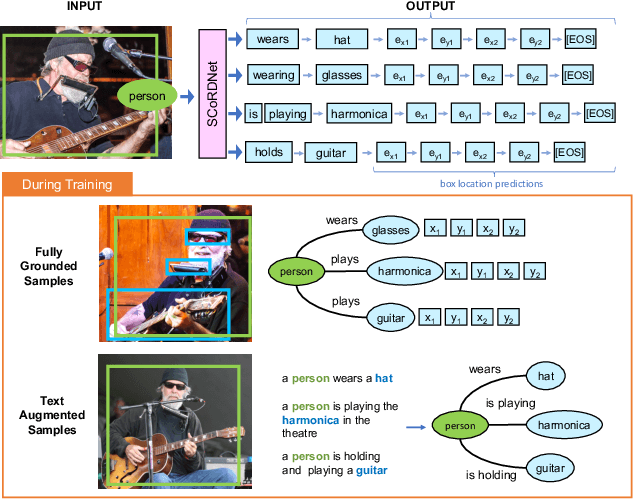
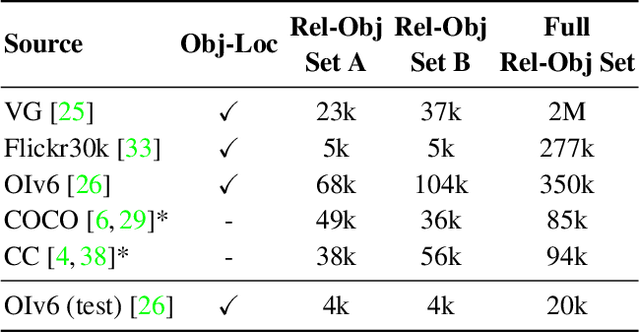
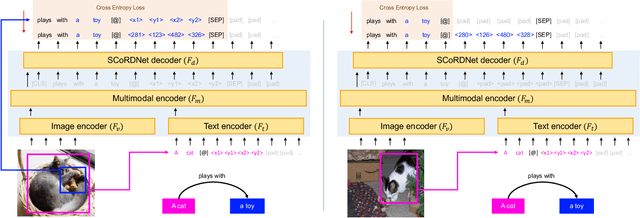
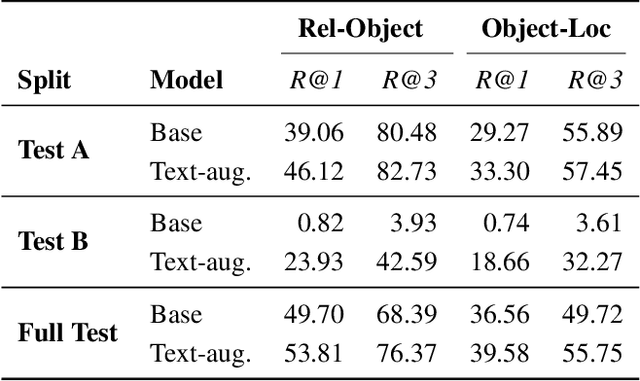
Abstract:We propose Subject-Conditional Relation Detection SCoRD, where conditioned on an input subject, the goal is to predict all its relations to other objects in a scene along with their locations. Based on the Open Images dataset, we propose a challenging OIv6-SCoRD benchmark such that the training and testing splits have a distribution shift in terms of the occurrence statistics of $\langle$subject, relation, object$\rangle$ triplets. To solve this problem, we propose an auto-regressive model that given a subject, it predicts its relations, objects, and object locations by casting this output as a sequence of tokens. First, we show that previous scene-graph prediction methods fail to produce as exhaustive an enumeration of relation-object pairs when conditioned on a subject on this benchmark. Particularly, we obtain a recall@3 of 83.8% for our relation-object predictions compared to the 49.75% obtained by a recent scene graph detector. Then, we show improved generalization on both relation-object and object-box predictions by leveraging during training relation-object pairs obtained automatically from textual captions and for which no object-box annotations are available. Particularly, for $\langle$subject, relation, object$\rangle$ triplets for which no object locations are available during training, we are able to obtain a recall@3 of 42.59% for relation-object pairs and 32.27% for their box locations.
Improving Visual Grounding by Encouraging Consistent Gradient-based Explanations
Jul 05, 2022
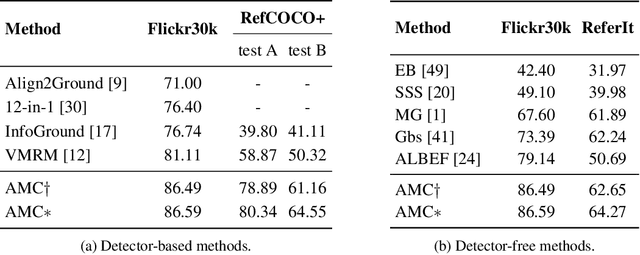
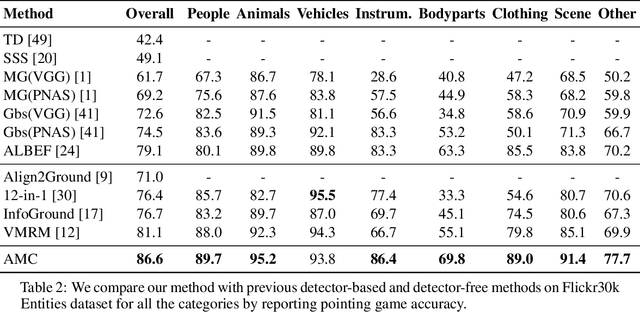
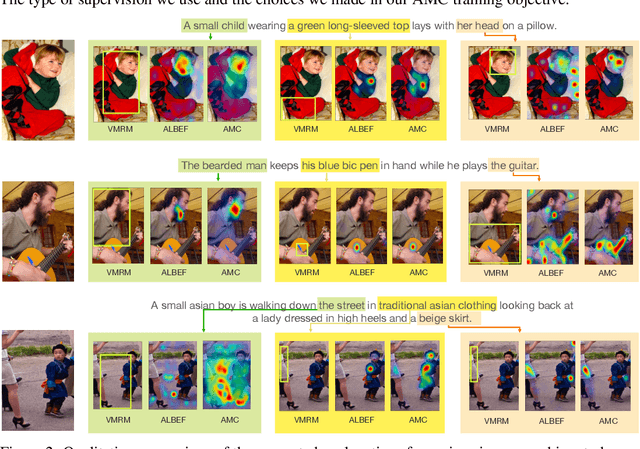
Abstract:We propose a margin-based loss for vision-language model pretraining that encourages gradient-based explanations that are consistent with region-level annotations. We refer to this objective as Attention Mask Consistency (AMC) and demonstrate that it produces superior visual grounding performance compared to models that rely instead on region-level annotations for explicitly training an object detector such as Faster R-CNN. AMC works by encouraging gradient-based explanation masks that focus their attention scores mostly within annotated regions of interest for images that contain such annotations. Particularly, a model trained with AMC on top of standard vision-language modeling objectives obtains a state-of-the-art accuracy of 86.59% in the Flickr30k visual grounding benchmark, an absolute improvement of 5.48% when compared to the best previous model. Our approach also performs exceedingly well on established benchmarks for referring expression comprehension and offers the added benefit by design of gradient-based explanations that better align with human annotations.
 Add to Chrome
Add to Chrome Add to Firefox
Add to Firefox Add to Edge
Add to Edge